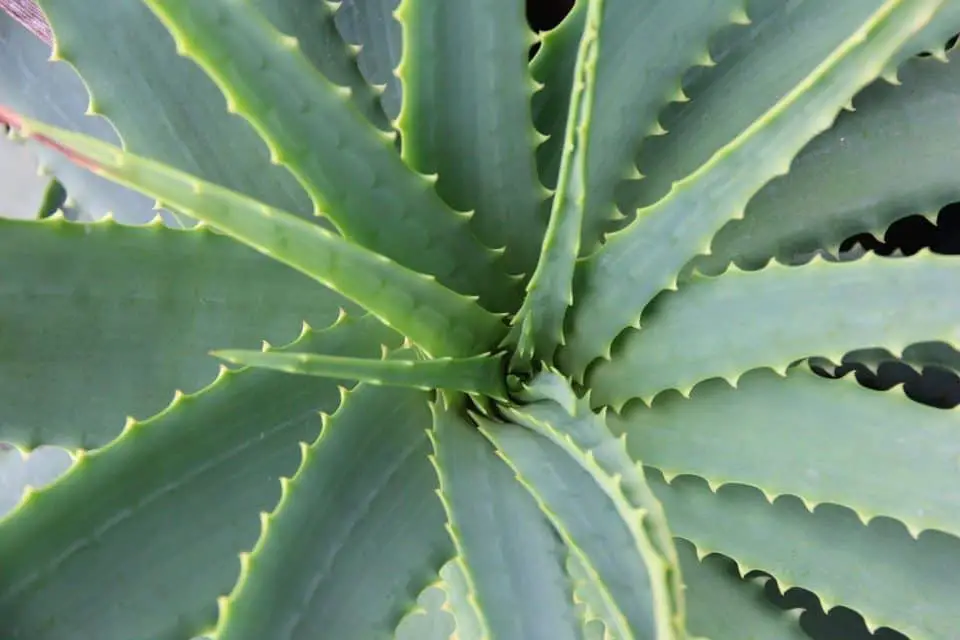Some links in the post are affiliate links and I get a commission from purchases made through some links found in the post.
The aloe vera plant has for long been used for medicinal purposes, both internally and externally.
From sunburns to digestive problems through to skin rashes, people rely on this plant for many reasons. It is thus not surprising that you would want to grow it in your home.
To get the propagation right, you need to understand some things about this plant. For one, this perennial succulent falls under the xerophytic classification.
That makes it hardy enough to survive both indoors and outdoors. That’s another reason why people love growing this plant – it calls for low maintenance and adds beauty to a space.
However, even with this easy propagation, you might still encounter several issues when growing this succulent.
So, here’s what you need to know about this plant, what it needs, and problems likely to arise.
Your Aloe Vera plant will turn different colors when it is exposed to non ideal conditions. This can lead to the leaves of the Aloe Vera plant turning yellow and pale, pink, purple and brown.
These color changes are caused by fungal diseases, bacterial infestations, poor watering, inadequate light, inadequate temperatures, poor nutrition, pests, transplant shock, root damage, too much salt and lack of phosphorus.
We will also cover how you can correct this for Aloe Vera plant in the rest of this article.
The Aloe Vera Plant
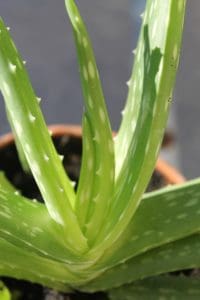 The aloe vera plant has its origins in Africa’s tropical regions and is known for its internal and external health benefits.
The aloe vera plant has its origins in Africa’s tropical regions and is known for its internal and external health benefits.
Not only does it work as a laxative, but it can also heal external wounds and bring down inflammation. But you probably already know this, hence the desire to propagate it.
This plant can grow up to three feet in height, though most varieties reach about two feet at most. Its surface features green spiny leaves that emanate from its center.
The best thing about this plant – it is drought resistant! Even so, you can still kill it by making a few mistakes, which we will later cover.
Aloe vera plants come in several varietals. These include Aloe variegata, Aloe aristata, and Aloe ‘Blue Elf’. Regardless of the variety, the premise is the same.
You need to have the plant in a well-lit area, water it frequently, and vary the temperatures. We will get into ideal growing conditions later.
For now, let us focus on what could go wrong. For example, did you know that aloe plants are poisonous to dogs and cats?
That’s a consideration to have in mind if you have pets at home. Away from that, let’s look at pests and diseases that could harm your plant.
Arising Problems
Fungal Diseases
Your aloe vera plant can get infested by a fungus such as aloe rust. In this case, the infestation would present as small and yellow spots, which would gradually turn brown and cover large areas.
Wilting and drooping can result from this. More often than not, this happens to plants in cool and humid conditions.
On the upside, no treatment is necessary for this condition, which also goes by the name Phakopsora pachyrhizi.
Anthracnose disease (Colletotrichum gloeosporioides) is another common fungal infection that manifests as circular light brown centers on the leaves.
These spots develop into reddish and brownish colors before merging to affect bigger portions of the leaves.
This condition can affect plants growing in warm and wet conditions and requires treatment via fungicide application.
Your plant can also suffer basal stem rot, where the base of the plant turns red then black before it starts to rot.
This condition, also known as Fusarium spp, affects plants growing in cold and wet regions. You can save the plant by cutting above the unaffected parts and re-potting these.
Bacterial Infestation
Have you heard of soft rot (Pectobacterium chrysanthemi)? This condition presents as rotting leaves, which turn dark accompanied by the wilting and collapsing of young leaves.
It can come about in hot and wet conditions and can lead to the death of plants if not dealt with early enough.
These infestations, most of which are avoidable, manifest in color changes, which you may have noticed in your plant.
If you have noticed any hue changes, you may want to continue reading as we uncover causes of the same and ways to prevent them.
Please note that some color changes are not due to infestation but owe to unsuitable growing conditions.
If you’re enjoying this article, check out out article on why does my aloe plant have no roots.
Why is my Aloe Vera Plant Turning Pale and Yellow?
Is your aloe vera plant turning pale? If yes, you are likely making mistakes in aftercare and watering practices, which can cause the plant’s death if not managed well.
Let’s look at common causes of yellowing and how you can deal with the same:
Poor Watering Practices
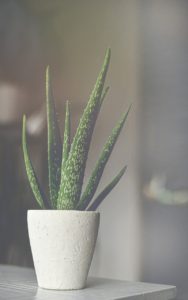 The fact that aloe vera is a xerophyte may confuse you regarding the water needed and watering frequency.
The fact that aloe vera is a xerophyte may confuse you regarding the water needed and watering frequency.
Well, here is what you need to know. Aloe vera leaves can hold a lot of water, and they do not need much watering. You thus need to strike a balance between watering too much and too little.
Overwatering takes place when you water the soil even when it is moist. That creates moist conditions that encourage root rot, as we earlier covered.
Unfortunately, this problem does not manifest in the early stages, and you only see its effect when the roots have rotted to a great extent, thus damaging the root system.
Without the adequate uptake of nutrients from the soil, the leaves turn yellow. If you have been overwatering, you need to give it a break and check for any root rot.
Where root rot is present, you will need to repot the plant as we will later cover. If not, you can leave the plant without water for a while and it should be fine.
Under-watering can also happen. Aloe vera leaves can generally stay without water for even three months.
However, you should avoid leaving the soil dry for too long as this dries up the roots, making it hard for the roots to absorb nutrients for the plants.
You have to remember that essential nutrients are available in soluble form and cannot get to the plant devoid of water, which serves as a carrier.
So, how should you water the plant? First, check that the soil has dried up to a depth of up to 5 centimeters.
If that is the case, you can dampen the soil instead of wetting or flooding it. If the plant is potted, ensure that the excess water drains.
Secondly, watch the watering frequency and water the plant once every 10 days, and only if the soil is dry to a 5cm depth. You can do it sooner if the soil tends to dry faster.
Inadequate Light
Another conundrum you will face with aloe vera is its light needs. It should neither have too much or too little light.
Too much sun can burn the leaves, which we will get into later. Having too little sun exposure, such as in a dark or semi-dark space, negatively affects photosynthesis, causing the yellowing of leaves.
Your plant should get at least 8 hours of daylight, even if it means supplementing with artificial lighting. Alternatively, you can move it to the southern window side for a better light angle.
Temperature Fluctuations
As seasons change, you may notice that your plant has started yellowing.
During spring and summer, the aloe will do well in temperatures of about 25°C, though it can survive drops of up to 18°C.
However, if the temperatures drop to 10°C, this will affect the plant’s growth, and yellowing is likely to arise.
If the temperatures reach 29°C and above, the leaves can burn, which we will cover under why your aloe vera plant is turning purple. Please note that artificial heating can also be a source of problems.
Solving this problem is easy. If the plant is indoors, move it to a warmer or cooler place, depending on the current temperature range in relation to the ideal growing conditions.
For example, if the temperatures are below 18°C, turn on the heat to get to anything between 18°C and 25°C.
Poor Nutrition
While it may not be necessary in most cases, aloe vera plants require nutritional supplements to grow healthily.
The soil should thus have fertilizers, adequate moisture, and draining capabilities. Any shortage in nutrition will manifest in the yellowing of the leaf tips and thinning leaves, which is not a pretty sight.
Yellowing indicates that you fertilize the soil too often, or the plant did not have sufficient water before fertilization, or the fertilization took place during the resting phase, or the plant was sprayed as opposed to liquid application of the fertilizer in the soil.
One or more of these factors could be to blame.
However, once again, you must strike a balance between too much and too little nutrition.
For example, if you fertilize the soil before transplanting, you should not add nutrients to the soil in the 6 months that follow.
Doing so would increase yellowing. If you notice that the plant is yellowing, you can try fertilizing it, but only if no fertilization has occurred in the last 6 months.
Diseases
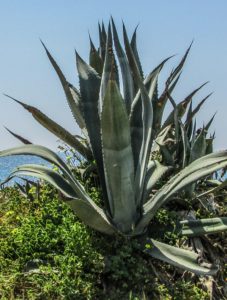 Out in the wild, aloe vera is not often subject to diseases, but all that changes once you plant it in indoor conditions which are favorable to pests and diseases.
Out in the wild, aloe vera is not often subject to diseases, but all that changes once you plant it in indoor conditions which are favorable to pests and diseases.
Root rot is a common problem that manifests in yellowing and thinning of leaves, slow plant growth, thin and fragile stems, and changes in soil smell.
These are signs that the plant is not getting enough nutrition owing to damage to the root systems.
This damage can arise from insufficient draining in the soil, compacting soil particles, and poor transplantation, all of which occur during propagation.
To save your plant, you can cut off the unaffected plants and re-pot these, this time looking into the soil’s state before planting.
Pests
Spider Mites
If pests attack your plant, yellowing will follow. For example, if spider mites attack the aloe, dead spots merge and cause overall yellowing of the leaves.
Note that if the yellowing starts to brown, the leaf dies, and you should thus address the problem as soon as it manifests.
Start by relocating the plant to prevent the spread of the pests before treating the affected parts with fungicide or herbal treatments.
The treatment should continue as per the instructions on the label.
Scale Insects
These insects settle in colonies and suck out the juice from the leaves, leading to drying of the leaves before yellowing and reddening and dying.
You should move the plant immediately and treat it using pesticides to avoid the spread of the pest.
Mealybug
If you notice waxy substances on the aloe vera leaves followed by yellowing of the tips, it is an indication that the mealybug is about to attack.
The wax deprives the leaves of oxygen and causes rotting and yellowing.
Get a pesticide immediately or wipe the affected regions with alcohol every ten days until the wax disappears.
You may also like: Aloe Vera Plant Leaves Bending
Why is my Aloe Vera Plant Turning Brown?
Browning often occurs if you allow yellowing to advance. Please refer to the correction measures as covered under an aloe vera plant turning pale and yellow where this is the case.
Ill-Advised Watering Practices
If you overwater your plant, the browning can show in two ways. It can be in the form of spots on the leaves, which indicates that yellowing has advanced.
However, you can still save your plant by reducing the watering frequency and amounts. If the browning shows at the base of the stem, root rot has advanced.
Under-watering causes drying of leaves and loss of chlorophyll, causing yellowing and then browning.
Under-watering presents as browning and drying of leaf tips, and this spreads slowly to other parts.
Temperature Variations
Browning can also indicate that the temperatures are too high (above 29oC). It presents as stunted growth, no blooming, and browning of leaves.
If that is the case, move the plant to a less heated and lit place or shading the plant (for outdoor plants).
Please note that this relocation should not be sudden. Also, you cannot solve high heat by additional watering, as this would not prevent the burning of leaves.
Winds & Cold
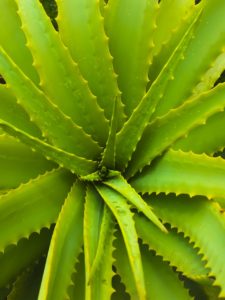 Wind can dry up the leaf and cause browning, which is common in draughty areas.
Wind can dry up the leaf and cause browning, which is common in draughty areas.
In this case, you should move the affected plant to a less windy place in the home or accord them shade in the outdoors.
Windbreaks help a lot, as do hedges and other barriers around the plant.
Cold weather can also be to blame as it can cause tissue decay and death of the plant due to the softening of the plant tissues.
Aloe does best in warm weather, and cold exposure can show in the form of reddish-brown hue changes.
The leaves can even become soft and transparent in extreme weather conditions.
Move the plant to a warmer place and prune the affected parts; else, the damaged tissues will affect the rest of the plant.
You can also cauterize the wounds. Do not water the plant for a while and give it time to recover its water retention abilities. In some cases, the plant may not survive the exposure.
While adult plants can withstand temperatures as low as 5oC, the ideal temperature range lies between 18oC and 25oC.
Poor Nutrition
You may either be giving your plant too much or too little nutrients. In the case of too many nutrients, quit fertilizing for a whole season.
If the situation does not improve, you can change the soil and repot the plant in well-drained soil.
Fungal Infections
We earlier stated that fungus can be to blame for change of color. While aloe is a hardy plant, it is not immune to fungal infections, more so in the indoors.
These infestations owe to humidity above 60%, too much moisture in the soil, and too much fertilization. In the case of the latter, nitrogen can make the plant more susceptible to attacks.
Gray Mold: this infestation appears as spores in gray, brownish hues, which occurs more so in spring and summer.
Other than using a fungicide, you should cut off the affected parts and burn them to prevent the spread of spores.
Additionally, you should be on the lookout for root rot and aloe vera rust, as earlier covered.
Why is my Aloe Vera Plant Turning Pink?
Is your aloe vera pink? This change can be quite disconcerting. However, knowing the causes can put your mind to ease. These include some we have covered under yellowing and browning, such as:
- Too much heat
- Poor watering practices
- Winds
- Inadequate lighting
- Root rot and
- Anthracnose disease
You can refer to their correction measures under yellowing and browning of aloe vera leaves. Additionally, your plant can turn pink due to:
Sunburn
As we earlier mentioned, too much sun is not good for your aloe vera and can result in sunburn.
When the plant sits in direct sunlight for long, tissue damage can occur, presenting as pink or red hue changes.
Unfortunately, you cannot treat the sunburn. All you can do is prevent it from occurring again by reducing sun exposure.
You can do this by shading the plant or moving it to an area that gets 8 hours of direct sunlight a day.
Transplant Shock
Aloe vera plants do not always react kindly to transplanting, which can present in a change of color.
This change can indicate root damage, change in temperature and soil conditions, increased heat or winds in the new location, or other changes to which the plant does not respond well.
The shock causes reduced delivery of nutrients to the leaves, hence the pink or red hue.
You can keep the plant healthy by looking at how much water you give it, the sunlight exposure, soil conditions, and other determining factors.
Make tweaks as covered under yellowing of leaves, and soon enough, the plant will likely be in good health.
Damage or Constriction in Roots
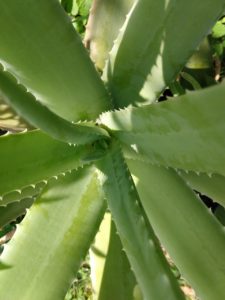 Changes in the root system can result from transplanting mistakes, salt exposure, or too much watering.
Changes in the root system can result from transplanting mistakes, salt exposure, or too much watering.
For example, if you move the plant to a small pot, constricting can take place, limiting the roots’ ability to take up nutrients for use in the plant.
To solve this problem, you need to loosen the soil around the plant and gently take it out of the pot.
Use sharp scissors to cut off any parts of the roots that are soft or have color changes before moving the plant to a bigger pot.
This solution works for all causes, ensuring that roots can now provide nutrients to the plant. You should be careful not to trigger such a change again, e.g., by overwatering the plant.
Too Much Salt
This problem relates to the use of too much fertilizer, which increases salinity in the soil conditions.
The roots take up the salt, which dries up other parts of the plant, including the leaves. You can correct this problem by running a lot of water through the soil to dilute and wash away the salt.
Make sure that most of the water drains to prevent waterlogging and root rot. Another option would be to transplant the aloe to another pot with light soil.
Why is my Aloe Vera Plant Turning Purple?
An aloe vera plant turning purple, while somewhat aesthetically pleasant, can be a cause of alarm.
You will be happy to know, though, that its causes are pretty much related to other causes of hue changes.
We have covered how you can reverse most of these changes under the yellowing and browning of aloe vera leaves.
They include:
- Temperature Fluctuations
- Too Much Watering
- Transplant Shock
Too Much Sunlight
Exposure to natural light does an aloe vera plant good. However, in warm seasons such as spring and summer, your plant requires shade; else, the leaves can burn and turn purple or red.
This change owes to anthocyanin production and is not dangerous to the plant.
Where the light is too much, you can shade the plant or move it to a less lit area.
Please wait a few days, then start watering it when the soil dries, and the green color should be back in no time.
Lack of Phosphorus
When your aloe vera plant does not get enough nutrients, it starts presenting this deficiency in the form of turning purple.
For example, if it does not have enough phosphorus, a change in hue can occur.
However, that does not mean that the soil does not have phosphorus. Diseases, low temperatures, and wet soil are known causes of altering the plant’s uptake of phosphorus.
As such, you should look into these factors and review their effects on the plant before making any necessary changes.
For example, if the temperature is below 18°C, that could be the cause. Try upping the temperature and see if anything changes.
If you rectify all likely causes and nothing changes, your soil may be low on phosphorus.
You can correct this by buying fertilizer from the store or using organic sources such as manure and bone meal. Keep in mind that this addition should be no more than every 6 months.
If you are enjoying this article, check out our article on why is my succulent turning purple.
How to Care for your Aloe Vera Plant
As you have seen, most color changes result from infestations, poor watering practices, too much or insufficient lighting, winds & cold, poor use of fertilizers, transplant shock, temperature variations, and many other avoidable causes.
Let us look into the appropriate techniques you should use when caring for your plant to avoid such occurrences:
Planting Care Practices
Potting
Caring for your plant starts at the planting stage. Any mistakes you make during this period affect your plant.
For example, if you choose a non-porous pot, waterlogging can take place, affecting the health of the plant and leading to color changes.
The planting pot should be porous to allow for water draining and adequate soil drying, preventing root rot.
Also, the pot should be heavy enough to withstand the weight of the mature plant without falling over.
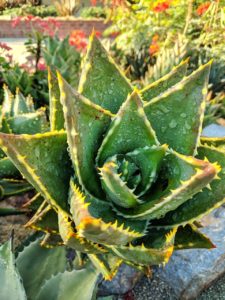 The pot should also be as wide as it is deep to allow the stem to fit into the soil. Fill the pot with well-draining soil instead of gardening soil that may not have sufficient nutritional value.
The pot should also be as wide as it is deep to allow the stem to fit into the soil. Fill the pot with well-draining soil instead of gardening soil that may not have sufficient nutritional value.
When planting outside, be sure to improve the soil using suitable fertilizers, but without overdoing it.
Fill the pot to a third of its depth with well-draining soil before placing the aloe in the pot and filling the pot with soil.
Leave at least an inch of space between the top of the soil and the rim of the container.
Unlike with other plants, you should not water the plant immediately.
Instead, please leave it to acclimate for a week to prevent root rot and allow the plant to develop new roots. Once it roots, you can move it to a warm place and start caring for it.
During Growth
Lighting
The plant should be in a well-lit area, either natural sun exposure or artificial lighting.
Aloe does well with at least 8 hours of daylight; else, it can be long-limbed, which is not ideal for indoor growing.
Temperature
Temperatures should range between 18 and 25°C. Anything below this is considered on the extreme side, though you can risk it with 13 and 29°C as your lower and upper limits.
If you see any color changes, move to the ideal range.
Watering
Watering should be deep, but in intervals of about 10 days. Wait until the soil is dry to about 5 cm depth before dampening the soil.
The soil should not be wet, and you should not allow the plant to sit in water, as this can encourage rotting.
If you can, you can even water the plant every 2 weeks, depending on climatic conditions. Always test the dryness before moistening the soil.
Fertilization
Fertilization is best done 6 months apart. If you can improve the soil once in spring and once in summer, that will yield great results.
Use a formula at ½ strength for best results to avoid over-fertilizing the soil.
For example, you can dilute 15-30-15 fertilizer by mixing it with five parts of water for every part of fertilizer.
Use the fertilizer in liquid form as opposed to spraying it on the leaves. Also, do not fertilize the soil during the plant’s dormant phases, such as during winter.
Pests & Diseases
Pests and diseases can affect your plant’s growth. Frequently check the plant’s surface for any pests and any changes in the form of the leaves.
Use pesticides to get rid of and to prevent infestations in the early stages.
Repotting
When roots become constricted or damaged, you should repot the plant as discussed earlier to give them more room to expand.
But in this case, you need to cut out the affected parts before repotting and allowing the plant to acclimate before watering.
To repot, you need to look at the current container holding the aloe.
If it is large enough to hold a mature plant, all you need to do is amend the soil and repot the plant as we covered under planting.
But if the pot is not large enough, you should get one that is three times the root ball’s size.
The root ball comprises both the roots and the dirt that clings to the base of the plant.
The essence of a large pot is to allow the roots to spread and grow without getting constricted. Remember that the pot should be well-draining.
Over time, the plant may start to outgrow its pot. You can tell by looking at the size of the leaves. If they are as long as the depth of the pot, you need a new container.
Once again, find a pot that is three times the root ball’s size and follow the acclimation procedures under the planting section.
Always fill the pot with soil, leaving an inch between the rim and the soil and ensuring that the leaves remain above the soil.
Final Thoughts: Aloe Vera Plant Turning Different Colors
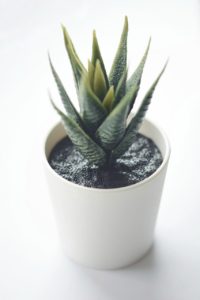 Generally, all you need to do is watch out for any hue changes and address them immediately if your aloe vera plant is turning color.
Generally, all you need to do is watch out for any hue changes and address them immediately if your aloe vera plant is turning color.
You can also check the surface of the leaves for any infestations to stay on track of any changes. Once you figure out the cause of the color change, work on addressing it.
Most problems are solvable, but only if you act fast. For example, if you address yellowing in leaves, you can prevent them from browning.
But if not, the leaves can brown, and the plant could eventually die from the cause.
The best approach is to remain proactive and stick to the recommended aftercare practices. Happy gardening!
Before you go, here are some more related articles I encourage you to read below to help solve more of your gardening issues:
3 Quick ways to Propagate a Christmas Cactus

